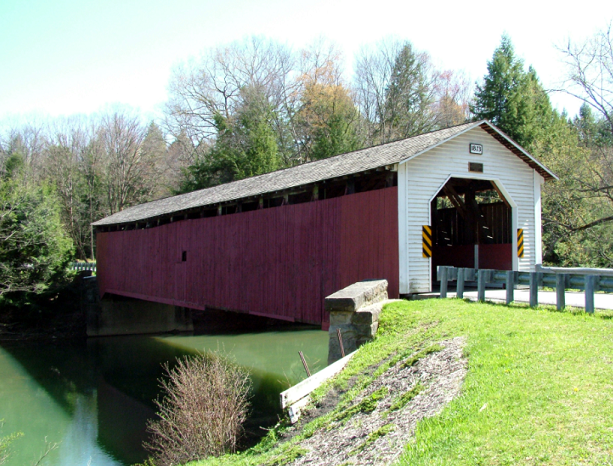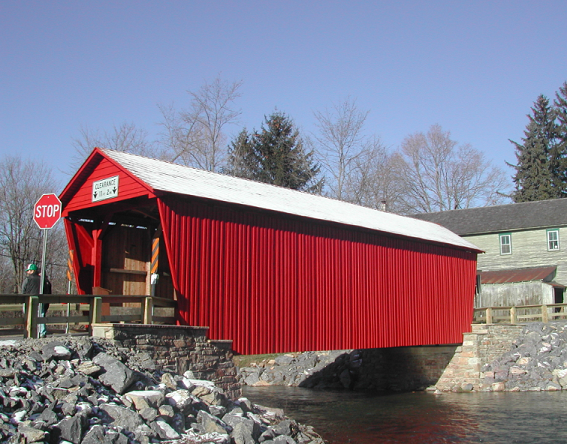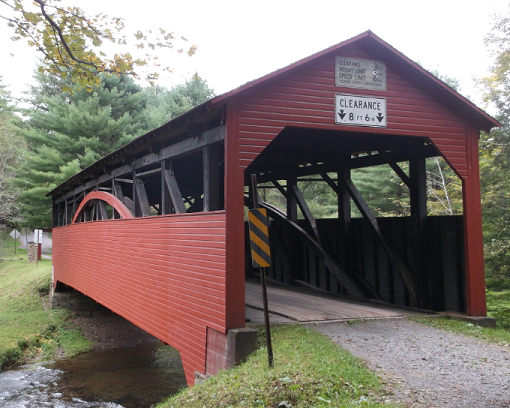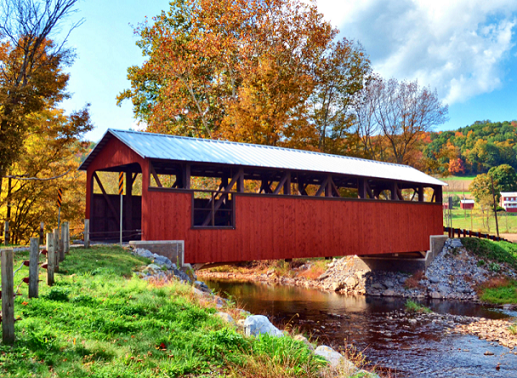Covered Bridges of the Pennsylvania Wilds
Covered bridges. Just the thought of them is romantic and quaint, bringing back memories of a lost era. Most historic covered bridges were built in the mid-1800s, with the roof on to protect their beams from weather.
Once plentiful, the number of historic covered bridges drops each year due to fire, vandalism, and weather damage. Estimates suggest that there are fewer than a thousand covered bridges still left in America, with two hundred and nineteen in Pennsylvania. Five of those lie within the PA Wilds, in the I-80 Frontier and the Pine Creek Valley & PA Grand Canyon. Almost all of them are on Covered Bridge Road. (You only think I’m kidding about this.)
There are several types of covered bridges, based on the design of the interior. The Pennsylvania Wilds has examples of three types. Described in my limited architectural understanding, a Kingpost truss has beams in a triangle, a Queenpost truss involves two slanted beams connected by one straight one above, and a Burr Arch has long, curved beams. (Understand that for purposes of this article, I am talking about historic covered bridges here. This includes bridges that date back a century or more, not decorative bridges built to enhance someone’s lawn or something.) By far, the most common style locally is the Burr Arch, which enabled the bridges to be longer and stronger.
McGees Mills Covered Bridge (Clearfield County)
This bridge is the only covered bridge in Clearfield County, and also the only covered bridge spanning the Susquehanna River. Built by Thomas A. McGhee in 1873, it’s a 122-foot Burr Arch truss. This bridge was renovated in 1994 after a collapse caused by some serious ice and snow.
The McGees Mills Covered Bridge is just outside Mahaffey, Clearfield County, near Route 219, along Covered Bridge Road. (Photo courtesy of Visit Clearfield County)

Logan Mills Covered Bridge (Clinton County)
This is the only covered bridge left in a county once filled with them. Built in 1874, the Logan Mills Covered Bridge is beside a historic mill in Sugar Valley. It crosses Fishing Creek, and is 64 feet long, with a Queenpost Truss. In 2003, it was refurbished by PennDOT after the Sugar Valley Historical Society campaigned to have it saved.
This bridge can be found just half a mile from Route 880, near Logan Mills. It sits on Logan Mills Road. (Photo courtesy of Clinton County Visitors Bureau)

Buckhorn Covered Bridge (Lycoming County)
Also known as Cogan House Covered Bridge, this one is a Burr Arch type built in 1877. It crosses Larry’s Creek. (South of this, there’s the Fink Covered Bridge over Larry’s Creek, which is scenic but not historic, as it was built in 1986.) It’s beside a private camp; you can drive over the covered bridge, but then you have to turn around and go back the way you came.
This bridge is just north of State Game Lands 114, and south of Route 184, along Campbell Road. (Photo by Lou Bernard)

Buttonwood Covered Bridge (Lycoming County)
The Buttonwood Covered Bridge is the northernmost in Lycoming County. It was built in 1898, a Kingpost truss style. It’s somewhere around seventy feet long (Sources vary on this, and I didn’t measure it myself.) Like all the covered bridges in Lycoming County, it is cared for by the county commissioners.
The Buttonwood Covered Bridge is just east of Highway 15. Take exit 284, drive north for about half a mile, and turn left onto Covered Bridge Road. (Photo by Lou Bernard)

Moreland/Fraser Covered Bridge (Lycoming County)
This one goes by three names, depending on who you ask: Moreland, Fraser/Frazier, or Lairdsville. It’s over Little Muncy Creek, almost eighty feet long, and is the easternmost covered bridge in the PA Wilds. This one is another Burr Arch type, a popular style in the area.
The Moreland/Fraser Covered Bridge is southwest of Lairdsville and just south of Route 118, along, of course, Covered Bridge Road. (Photo courtesy of Lycoming County Visitors Bureau)

If you’re a fan of covered bridges, it’s possible to see them all within a day, though I would recommend maybe taking it a bit slower. It’s well worth the drive to see them all, these beautiful remnants of the past.



Fantastic!